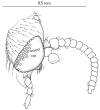Parisognoriste, a new genus of Lygistorrhinidae (Diptera: Sciaroidea) from the Oise amber with redescription of Palaeognoriste Meunier
- PMID: 21594116
- PMCID: PMC3088022
- DOI: 10.3897/zookeys.50.506
Parisognoriste, a new genus of Lygistorrhinidae (Diptera: Sciaroidea) from the Oise amber with redescription of Palaeognoriste Meunier
Abstract
A new genus and a new species of Lygistorrhinidae, Parisognoristeeocenica is described from the Eocene Oise amber of the Paris Basin. Parisognoristesciariforme Meunier, 1904 and Parisognoristeaffine Meunier, 1912 are re-described. Lectotypes are designated for both species of Palaeognoriste. The phylogenetic positions of the new genus and Palaeognoriste Meunier are discussed. The paper is an example demonstrating a new approach in cybertaxonomy including automatic generation of manuscript within Virtual Research Environment (Scratchpads), semantic enhancements, and parallel release of the publication on paper and on-line accompanied with registration of new taxa with ZooBank.
Keywords: Eocene; fossil resin; new taxa; phylogeny; taxonomy.
Figures






References
-
- Blagoderov V, Hippa H, Ševčík J. (2009) Asiorrhina, a new Oriental genus of Lygistorrhinidae (Diptera: Sciaroidea) and its phylogenetic position. Zootaxa 2295: 31–45. http://www.mapress.com/zootaxa/2009/f/z02295p045f.pdf
-
- Goloboff P. (1999) NONA, version 2.0. Tucuman, Argentina. Fundacion e Instituto Miguel Lillo.
-
- Grimaldi D, Blagoderov V. (2001) A new genus of Lygistorrhinidae from Vietnam (Diptera: Sciaroidea), and phylogenetic relationships in the family. Studia Dipterologica 8: 43–57.
-
- Hippa H, Mattsson I, Vilkamaa P. (2005) New taxa of the Lygistorrhinidae (Diptera: Sciaroidea) and their implications for a phylogenetic analysis of the family. Zootaxa 960: 1–34. http://www.mapress.com/zootaxa/2005f/z00960f.pdf
LinkOut - more resources
Full Text Sources
